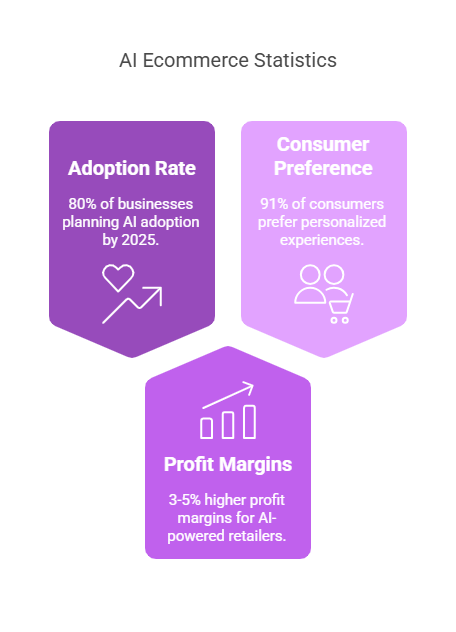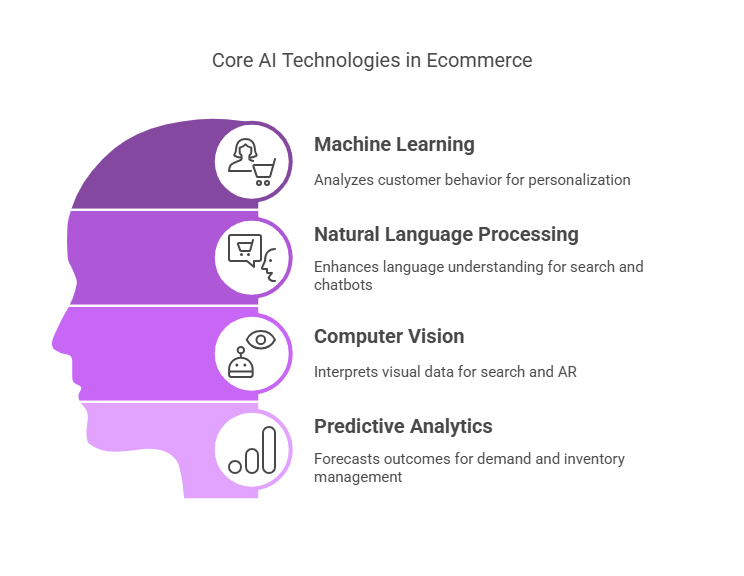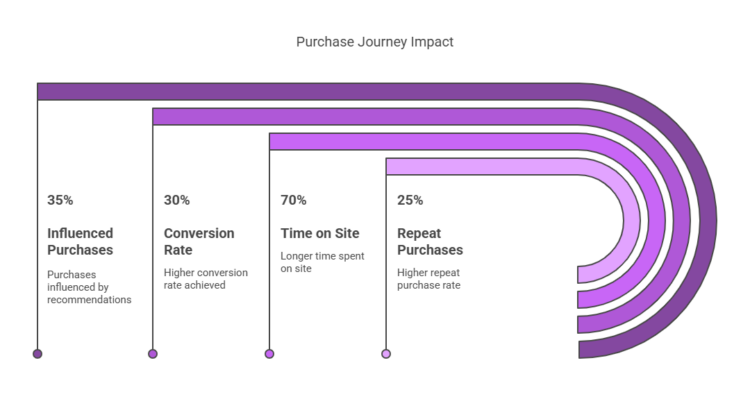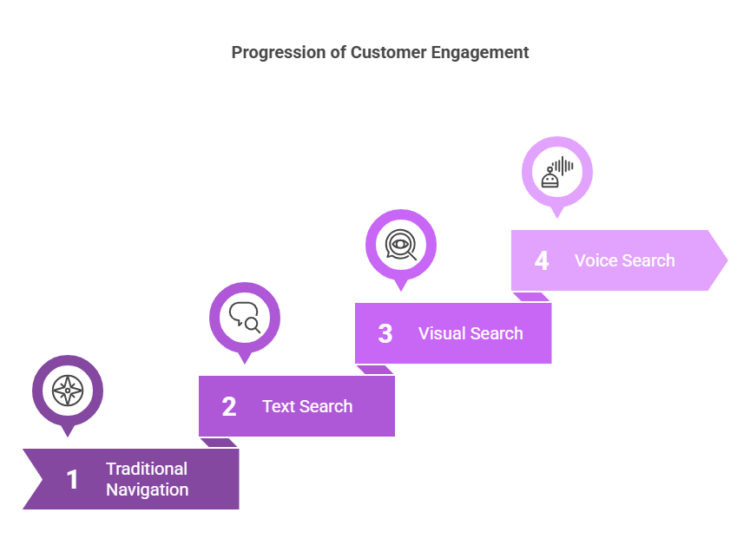
Did you know that 80% of ecommerce businesses plan to implement AI solutions by 2025? A recent McKinsey study found that AI-powered retailers achieve 3-5% higher profit margins than their competitors.
Table of Content
Artificial intelligence isn’t just changing ecommerce. It’s completely revolutionizing how online stores operate, compete, and succeed in an increasingly digital marketplace. The difference between thriving and merely surviving in today’s ecommerce landscape often comes down to one factor: how effectively businesses leverage AI technology.

Here you will explore twelve powerful ways AI is transforming ecommerce and how your business can capitalize on this technological revolution.
AI adoption in ecommerce has skyrocketed over the past three years. Nearly 45% of online retailers now use at least one form of artificial intelligence, and the global AI in retail market is projected to reach $19.9 billion by 2027.

Ecommerce businesses face unique challenges that AI is uniquely positioned to solve. Managing vast product catalogs efficiently. Delivering personalized shopping experiences at scale. Optimizing complex pricing strategies in real-time. Predicting inventory needs across multiple channels.
Look at how Amazon revolutionized online shopping through AI. Their recommendation engine drives 35% of their total sales. This single AI application generates over $125 billion annually. Meanwhile, 91% of consumers say they’re more likely to shop with brands that provide personalized experiences.
Four fundamental AI technologies are reshaping the ecommerce landscape:

These core technologies form the foundation for the transformative applications we’ll explore next.
AI-powered recommendation engines analyze thousands of data points to suggest products customers are most likely to purchase. These recommendations now drive 35% of all ecommerce purchases.

Modern recommendation systems go far beyond “customers who bought this also bought…” They consider browsing history, time spent viewing specific items, purchase patterns, demographic information, and current trends.
Fashion retailer Stitch Fix uses AI to analyze over 100 data points per customer. Their recommendation engine has helped them achieve a 30% higher conversion rate than industry averages. Additionally, customers who engage with AI recommendations spend 70% more time on site.
Traditional search functions rely on keyword matching. AI-powered search understands customer intent. About 43% of ecommerce visitors go directly to the search bar, making this a critical conversion point.
When a customer searches for “summer dress,” an AI search engine understands context: season, style preferences, price sensitivity, and current fashion trends in the customer’s region.
Companies implementing AI search report up to 50% increases in conversion rates and 37% higher order values. The technology ensures customers find exactly what they’re looking for—even when they use imprecise search terms. In fact, AI-powered search can understand and correctly respond to queries that are off by as many as 2-3 keywords.
Visual search lets customers find products by uploading images rather than typing descriptions. By 2024, the visual search market is expected to exceed $14.7 billion.
A customer sees a pair of shoes they like on social media. With visual search, they can upload the image to your store, instantly see similar products you offer, and browse variations in different colors or styles.
Pinterest’s visual search tool increased user engagement by 40%. Ecommerce businesses implementing this technology report similar improvements in customer satisfaction and sales. ASOS saw a 75% increase in mobile purchases after implementing visual search capabilities.

AI chatbots provide 24/7 customer support and personalized shopping guidance. By 2025, 95% of customer interactions will be handled by AI, with chatbots leading the way.
Modern ecommerce chatbots can answer product questions instantly, guide customers through product selection, process returns, provide shipping updates, and offer personalized recommendations.
Luxury retailer Burberry’s chatbot increased in-store appointments by 33%. Online-only retailers report even higher impact from implementing conversational AI. H&M’s chatbot improved cart conversion by 19% and increased average order value by 26%.
AI pricing tools analyze market conditions, competitor pricing, and customer behavior to set optimal prices in real-time. Retailers using AI pricing see an average profit margin increase of 7.9%.
These systems consider competitor price changes, current inventory levels, customer demand patterns, and price elasticity by product category. Sophisticated systems can make up to 2.5 million price changes daily.
Airlines have used dynamic pricing for decades. Ecommerce retailers implementing similar AI-powered strategies report margin improvements of 5-10%. Amazon changes prices every 10 minutes on their most competitive products, helping them maintain their price leadership position.
AI fraud detection systems analyze transactions in milliseconds to identify suspicious patterns. Ecommerce businesses lose approximately $20 billion annually to fraud, making AI detection critical.
These systems examine unusual purchasing patterns, mismatches between shipping and billing information, and abnormal browsing behavior before purchase. Advanced systems can detect synthetic identity fraud that combines real and fake information.
PayPal reduced its fraud rate by 50% after implementing machine learning algorithms. Ecommerce retailers experience similar benefits while reducing false positives that reject legitimate customers by up to 70%. Every $1 invested in AI fraud prevention saves an average of $2.64 in fraud losses.
AI forecasting tools predict future demand with remarkable accuracy. Retailers using AI forecasting reduce inventory costs by an average of 30%.
Traditional forecasting relies on historical sales data. AI systems incorporate social media trends, weather forecasts, upcoming events, economic indicators, and competitive activity. Leading systems can detect early demand signals up to 12 weeks before traditional methods.
Walmart reduced stockouts by 30% after implementing AI inventory management. Smaller ecommerce businesses report even greater improvements when switching from manual forecasting. The average forecast accuracy improvement is 20-30 percentage points when switching to AI.

AI sentiment analysis tools monitor customer feedback across channels to identify issues and opportunities. Businesses using sentiment analysis respond to emerging issues 4x faster than those using manual monitoring.
These systems analyze product reviews, social media mentions, customer service interactions, survey responses, and return reason codes. Advanced platforms can detect emerging trends up to 2 weeks before they appear in sales data.
Beauty retailer Sephora uses sentiment analysis to identify emerging product trends. This helped them increase their new product success rate by 25%. Additionally, sentiment-aware companies achieve Net Promoter Scores that are 22 points higher than industry averages.
Voice-powered shopping through smart speakers and virtual assistants represents the next frontier in ecommerce convenience. By 2025, voice commerce is projected to reach $80 billion in annual sales.
Voice commerce enables hands-free ordering of repeat purchases, natural language product searches, and quick reordering of frequently purchased items. About 45% of millennials already use voice assistants while shopping.
Early adopters are gaining valuable experience with this rapidly growing channel. Brands with voice skills see 30% higher customer engagement. Domino’s Pizza reported that 65% of their voice assistant orders came from customers who had never ordered online before.
AR technology allows customers to visualize products in their own environment before purchasing. The AR retail market is expected to reach $7.9 billion by 2025.
Furniture retailers let customers see how pieces would look in their homes. Cosmetics brands allow virtual “try-on” of makeup products. Fashion retailers enable virtual fitting rooms. IKEA’s AR app users are 3x more likely to purchase after using the feature.
Shopify reports that merchants using AR content see 94% higher conversion rates. The technology dramatically reduces return rates for visually-oriented products by up to 40%. Customers spend 2.7x longer on websites with AR features.
AI algorithms optimize complex supply chain operations far more efficiently than humans could. Businesses using AI-driven supply chains reduce logistics costs by an average of 15%.
These systems manage optimal shipping routes, warehouse space utilization, multi-location inventory allocation, and delivery time predictions. Advanced platforms can simulate 10,000+ scenarios to find optimal solutions.
Home improvement retailer Lowe’s reduced delivery costs by 20% after implementing AI logistics optimization. Online retailers experience similar benefits while improving delivery speed by an average of 25%. AI-managed supply chains reduce carbon emissions by up to 15% through more efficient routing.
AI content tools create unique, SEO-optimized product descriptions at scale. Retailers with AI-generated product content report 30% higher search visibility on average.
When managing thousands of products, creating unique descriptions becomes impossible manually. AI systems can generate compelling product descriptions, adapt content for different customer segments, and optimize text for search visibility.
Clothing retailer ASOS uses AI to generate descriptions for their 85,000+ products. This improved their search visibility by 35% while reducing content creation costs by 40%. The Iconic achieved a 17% higher click-through rate with AI-optimized product titles.
AI isn’t just another technology trend in ecommerce—it’s a complete paradigm shift in how online businesses operate.
From personalized shopping experiences to optimized back-end operations, artificial intelligence is creating unprecedented opportunities for businesses willing to embrace its potential.
The question is no longer whether to implement AI in your ecommerce business, but which applications to prioritize and how quickly you can integrate them.
The most successful retailers in the coming decade will be those who recognize AI not as a cost center, but as their primary competitive advantage in an increasingly sophisticated digital marketplace.
At Code Brew Labs, we’ve helped dozens of ecommerce businesses successfully implement the AI technologies discussed in this article. Our team of experts specializes in seamlessly integrating AI solutions that deliver measurable ROI without disrupting your existing operations.
Our experience spans the entire AI implementation journey—from initial readiness assessments to full-scale deployments. We understand that every ecommerce business has unique needs. That’s why we take a consultative approach, recommending only the AI solutions that align with your specific business goals and technical infrastructure.
The question is no longer whether to implement AI in your ecommerce business, but which applications to prioritize and how quickly you can integrate them. The most successful retailers in the coming decade will recognize AI not as a cost center, but as their primary competitive advantage.
Ready to transform your ecommerce business with AI? Contact Code Brew Labs today to schedule your free AI readiness assessment and take the first step toward a more intelligent, profitable future.
